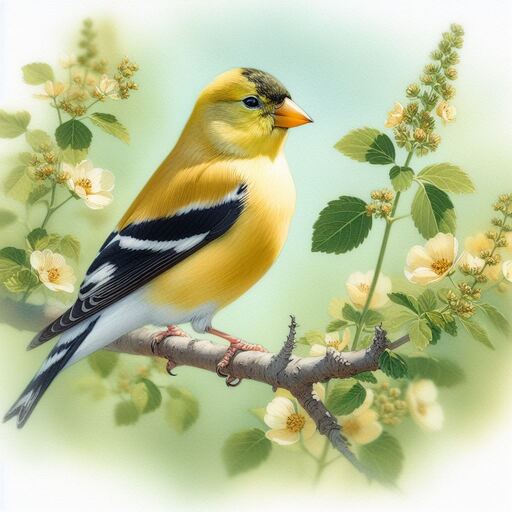Most beautiful small birds - Sykalo Eugen 2024
American Goldfinch (Spinus tristis)
Identification:
- Species name: American Goldfinch
- Scientific name: Spinus tristis
- Family: Fringillidae (Finches)
- Order: Passeriformes (Songbirds)
- Subclass: Neornithes (Modern birds)
- Class: Aves (Birds)
Description:
- Size: Small songbird, 11-14 cm (4.3-5.5 in) long with a wingspan of 19-22 cm (7.5-8.7 in).
- Body shape: Stocky with small head, long wings, and short, notched tail.
- Plumage color:
Males (breeding season): Bright yellow body with black cap, wings, and wingbars. White underparts.
Females: Dull yellow below and olive above with two distinct wingbars. Brownish streaking on head and body.
Winter: Both sexes become drab, buffy-brown.
- Beak: Short, conical, and brown. Adapted for seed eating.
- Legs: Slender and brown.
- Tail: Short and forked.
Behavior:
- Feeding: Highly acrobatic, clinging to plants like thistle and seeds socks to feed on seeds. Forages in flocks except during breeding season.
- Reproduction: Builds cup-shaped nests in trees or shrubs. Lays 4-6 pale blue eggs with dark markings. Both parents feed the young. Breeds later than most North American birds, often starting in mid-summer.
- Movement: Migratory, traveling from mid-Alberta to North Carolina for breeding and south to Mexico for winter. Flies with a bouncy, undulating pattern.
- Communication: High-pitched, twittering calls and a distinctive "potato-chip" flight call.
Ecology:
- Habitat: Primarily open areas with abundant thistles and seed-bearing plants. Found in weedy fields, floodplains, cultivated areas, roadsides, orchards, and backyards.
- Diet: Mainly seeds, including thistle, sunflower, ragweed, and dandelion.
- Hunting methods: Gleans seeds from plants, sometimes hanging upside down or clinging to stems.
Distribution:
- Found throughout much of North America, from southern Canada to northern Mexico.

The American Goldfinch, with its vibrant yellow plumage and acrobatic flight, is a cheerful sight in any backyard. But beneath its beauty lies a fascinating avian wonder full of scientific surprises and curious quirks. Get ready to be amazed by these feathery facts:
A Master of Molt: Unlike most birds who molt once a year, the American Goldfinch undergoes a double molting cycle. In late winter, they transform from drab winter colors to a stunning sunshine yellow, perfect for spring courtship. Then, in late summer, they molt again, adopting a slightly different yellow outfit for fall foraging. Talk about keeping up with the latest feathered trends!
Vegetarian Virtuosos: These finches are strict seed-eaters, meticulously extracting and dehusking tiny seeds with their precise, conical bills. Their taste buds are incredibly sensitive, allowing them to identify and prefer seeds with the highest nutritional value. They're the connoisseurs of the birdseed buffet!
Thistle Whisperers: Thistles aren't just a tasty treat for goldfinches; they're essential building materials. These birds construct their delicate nests using fluffy thistle down, creating a cozy haven for their chicks. Talk about sustainable living!
Acrobatic Aerialists: Watch a flock of goldfinches in flight and be mesmerized by their aerial ballet. They perform tight-knit maneuvers and acrobatic dips, often soaring and gliding with effortless grace. Their agility comes from their light weight and specialized wing structure, making them masters of the air.
Singing Secrets: The goldfinch song, a melodious and intricate sequence of chirps and whistles, serves a dual purpose. It's a beautiful declaration of territory and a way to attract mates. Interestingly, male goldfinches learn their songs from other males, creating a unique musical dialect within their flock.
Feathery Fashion Faux Pas: Don't be fooled by the vibrant yellow males; in the world of goldfinches, females play it cool. Their olive-green plumage offers better camouflage while nesting and caring for chicks. But there's a twist: during courtship, some females develop temporary patches of yellow, mimicking the males to assess their suitability as partners. A sneaky strategy indeed!
Unexpected Flock Mates: While goldfinches often form their own flocks, they're not afraid to mingle. They're frequently seen socializing with other seed-loving birds like pine siskins and common redpolls, sharing foraging tips and enjoying the company of feathered friends.